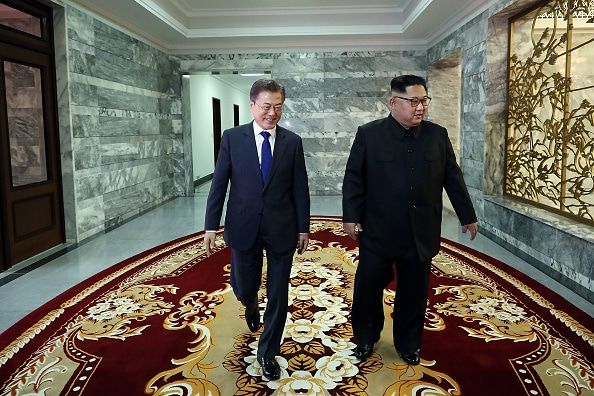Sig Hecker on North Korea in 2018
By Katy Gabel Chui | February 13, 2019
 South Korean President Moon Jae-in, left, walks with North Korean leader Kim Jong-un, right during their meeting on May 2018 in Panmunjom, North Korea.
South Korean President Moon Jae-in, left, walks with North Korean leader Kim Jong-un, right during their meeting on May 2018 in Panmunjom, North Korea.
In May 2018, Stanford Center for International Security and Cooperation (CISAC) scholars Siegfried Hecker, Robert Carlin, and Elliot Serbin released an in-depth report analyzing the nuclear history of North Korea between 1992 and 2017 alongside a historical research-based “roadmap” for denuclearization.
Since then, tensions between North Korea and South Korea have thawed. United States President Trump met with Kim Jong-un in Singapore in June, and another U.S.-North Korea summit is planned for later this month.
Today, the CISAC researchers release a 2018 update to their report, chronicling and analyzing historic developments in North Korea over the past year. In this Q&A with Katy Gabel Chui, CISAC senior fellow and former director of the Los Alamos National Laboratory Siegfried Hecker shares what the team learned:
Your research demonstrates that South Korean, North Korean, and U.S. efforts in 2018 were able to lower tensions and the threat of war on the Korean Peninsula. How? What actions were most effective toward this end?
At the end of 2017, the Moon Jae-in administration in South Korea made secret overtures to the Kim Jong-un regime. Kim Jong-un responded positively in his 2018 New Year Speech, proposing to send North Korean athletes to the South as part of a joint delegation for the 2018 Winter Olympics in Seoul. He also initiated serious diplomatic overtures to Washington. These efforts led to the North/South Summit in April and the historic Singapore Summit in June.
Yet, in spite of these positive initiatives, you did not rate U.S. and North Korean diplomacy at your highest level, why is that?
We stopped one level short for both (a G2 instead of a G3) because progress in talks that followed the summit quickly hit a wall when the US side called for the North to produce a full declaration of its nuclear weapons program, to which Pyongyang responded angrily. The rest of the year was up and down. Nevertheless, the Singapore Summit took the critical step away from the brink of war. The North and South also continued to make remarkable progress toward reconciliation with two more presidential summits.
Most of the focus in the U.S. has been on an apparent failure of North Korea to denuclearize. But you note in your research that the Singapore summit pledged normalization and denuclearization. Why has progress stalled?
First, denuclearization is a poorly defined concept. We should focus on the elimination of the North’s nuclear weapons, the means of production and means of delivery. Second, Washington has so far not taken steps toward normalization. It has insisted on maintaining maximum pressure and sanctions, which Pyongyang considers incompatible with normalization.
Nevertheless, you claim that the threat posed by North Korea was substantially reduced. What about the North’s nuclear capabilities – were these reduced in 2018?
The diplomatic initiatives have greatly reduced the threat. Our study, which looks at the details of how the capabilities have changed in 2018, concludes that the rapid escalation of overall capabilities in 2017 and prior years was halted and in some cases rolled back.
But your research also shows North Korea continued to operate its nuclear weapons complex in 2018, and that it is still producing plutonium and highly enriched uranium.
We are not surprised that North Korea has not halted its fissile materials production in absence of formal negotiations. Our analysis of open-source satellite imagery of the Yongbyon complex led us to estimate they may have added sufficient plutonium and highly enriched uranium for an additional 5 to 7 nuclear weapons on top of our 2017 estimate of approximately 30 weapons.
There have also been reports that it has continued to maintain, produce, and deploy its land-based ballistic missiles. These activities don’t look like the North is denuclearizing.
In our study, we look at the three requisites for a nuclear arsenal – fissile materials, weaponization (that is design, build, and test), and delivery. The North did continue to produce fissile materials. But it took the remarkable step to end nuclear testing and long-range missile testing at a time during which North Korea had been rapidly increasing the sophistication of its nuclear weapons and missiles and their destructive power and reach. Therefore, we conclude that the North not only halted that rapid advance but also rolled back the threat we judged the North’s nuclear and missile programs to pose in 2017.
It sounds like there is a long way to go to denuclearize. In May of last year, you released a framework for denuclearization of North Korea based around a “halt, roll back and eliminate” process. Where does North Korea stand, if anywhere, in that process today?
Our color charts track the progress. Contrary to what we have heard in the media, North Korea has actually halted and rolled back some nuclear activities, with the most important being the end of nuclear and missile testing, which in turn, has significant consequences. In fact, in 2018 it did not flight test missiles of any range. However, the road to final elimination will be long and difficult, especially because of the serious trust deficit between Washington and Pyongyang. We suggested a 10-year time frame last year.
Haven’t you also suggested a way to speed up that process?
Yes, we propose that North Korea, South Korea, and the U.S. explore cooperative efforts to demilitarize North Korea’s nuclear and missile programs and convert them to civilian nuclear and space programs. Such cooperation has the potential of accelerating the elimination of nuclear weapons and nuclear weapons program. It will, in the long term, also greatly improve the prospects of adequate verification.
How do you get North Korea to go along with any of these ideas?
That’s the job of our negotiators. When Special Representative Stephen Biegun was here at Stanford recently, he showed a lot of flexibility to have the U.S. phase denuclearization with normalization. I think that’s what it will take. But a lot of hard work lies ahead.
Full Report: A Comprehensive History of North Korea’s Nuclear Program: 2018 Update
Editor’s note: This interview was originally published by the Center for International Security and Cooperation (CISAC) at Stanford University.
Together, we make the world safer.
The Bulletin elevates expert voices above the noise. But as an independent nonprofit organization, our operations depend on the support of readers like you. Help us continue to deliver quality journalism that holds leaders accountable. Your support of our work at any level is important. In return, we promise our coverage will be understandable, influential, vigilant, solution-oriented, and fair-minded. Together we can make a difference.
Topics: Interviews, Nuclear Risk, Nuclear Weapons















